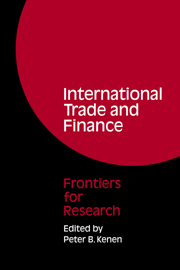Book contents
- Frontmatter
- Contents
- List of Contributors
- Preface
- PART I TRADE, PROTECTION, AND DOMESTIC PRODUCTION
- Testing Trade Theories
- The Costs and Consequences of Protection: A Survey of Empirical Work
- Trade Policies and Economic Development
- Discussion
- PART II ECONOMETRIC MODELS OF TRADE AND PAYMENTS
- Part III PAYMENTS ADJUSTMENT AND THE MONETARY SYSTEM
- PART IV AN OVERVIEW AND AGENDA
- Glossary of Frequently Used Acronyms
- Author Index
Discussion
Published online by Cambridge University Press: 05 November 2011
- Frontmatter
- Contents
- List of Contributors
- Preface
- PART I TRADE, PROTECTION, AND DOMESTIC PRODUCTION
- Testing Trade Theories
- The Costs and Consequences of Protection: A Survey of Empirical Work
- Trade Policies and Economic Development
- Discussion
- PART II ECONOMETRIC MODELS OF TRADE AND PAYMENTS
- Part III PAYMENTS ADJUSTMENT AND THE MONETARY SYSTEM
- PART IV AN OVERVIEW AND AGENDA
- Glossary of Frequently Used Acronyms
- Author Index
Summary
TESTING TRADE THEORIES: A COMMENT
I have been asked to focus particular attention on Stern's paper. Stern has, I think, provided us with an excellent, comprehensive survey of trade theories, together with the results and the difficulties of testing these theories. I shall therefore limit my comments to some of the issues he raises concerning the directions in which we should now try to move on both the theoretical and empirical levels.
The present state of trade theory is far from satisfactory. Tests of the Heckscher–Ohlin factor-proportions theory have shown that, at least in its simple form, it does not perform very well in predicting the commodity composition and direction of trade. As yet, however, we do not have a well worked out theory to replace it. We have lots of bits and pieces with which to amend the Heckscher–Ohlin approach, but we do not know how significant each part is or how the parts are tied together. Consequently, most of us, in presenting the pure-theory side of trade to our students, still spend considerable time carefully building up the simple Heckscher–Ohlin–Samuelson trade model and then examining such theorems as the Stopler–Samuelson proposition, the Rybczynski effect, and the factor-price equalization theorem. The appeal of the model, of course, is that it enables us to relate price changes all the way back to the distribution of income.
- Type
- Chapter
- Information
- International Trade and FinanceFrontiers for Research, pp. 151 - 172Publisher: Cambridge University PressPrint publication year: 1976



